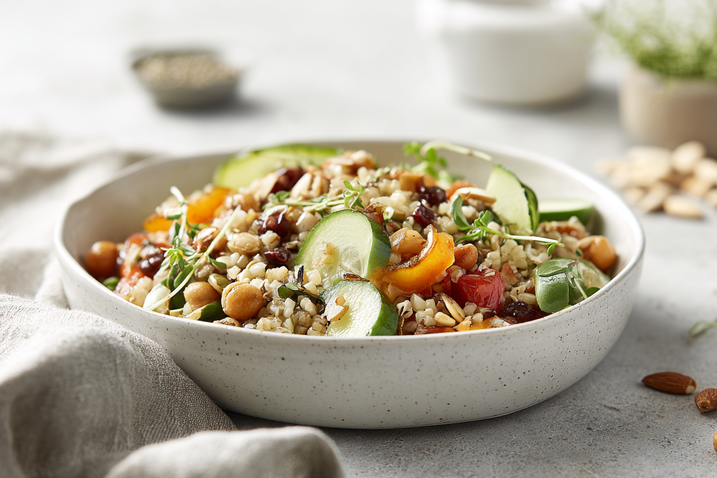Phytonutrients Explained: How Plant Power Supports Your Health
If you love to enjoy food with all your senses, you’ve already met phytonutrients. They give fruits and vegetables their vibrant colors and distinctive aromas – from the deep red of tomatoes to the refreshing scent of mint. But beyond their role as natural pigments, these plant compounds offer so much more for your health.
)
Table of contents
What are phytonutrients?
Secondary plant substances are color, scent, and flavor compounds in plants. Their task is to protect plants from the sun and predators, as well as to attract insects for pollination to ensure their reproduction. The carotenoid lycopene gives tomatoes their red color, and the allicin gives garlic its smell.
So far, 100,000 of them are known, of which 5,000 to 10,000 come from our food. Due to their chemical structure and functional properties, secondary plant compounds are classified into various subgroups.
Among the most important secondary plant compounds are:
• Carotenoids (such as beta-carotene, astaxanthin, zeaxanthin, lycopene in carrots, pumpkin, or tomatoes)
• Chlorophyll (found in green leafy vegetables such as spinach and chard)
• Flavonoid (found in yellow, red, and blue fruits and vegetables)
• Glucosinolate (for example in broccoli, red cabbage, and kohlrabi)
• Monoterpene (found in citrus fruits, peppermint)
• Phytosterols (found in nuts, legumes, soy)
• Polyphenols (e.g. resveratrol in grapes)
• Saponin (found in legumes, oats, asparagus)
• Sulfide (in onions and leeks)
Where can phytonutrients be found?
As the name suggests, secondary plant compounds are found exclusively in plants and thus in plant-based foods. These include vegetables, fruits, potatoes, legumes, nuts, herbs, and whole grain products.
In most types of fruits, vegetables, and grains, they are mainly found in the outer layers or in the skin - good reasons, for example, not to peel apples, but only to wash them thoroughly.
Phytonutrients = Supernutrients
However, phytochemicals have much more to offer than just color and flavor. Scientists have recognized that phytochemicals, along with vitamins and trace elements, determine the health value of plant-based foods. Although they are not essential for life or provide energy to humans like micronutrients and macronutrients, numerous observational studies have shown the connection between phytochemicals and our well-being on various levels. However, these positive results are related to conventional foods and not isolated substances. Therefore, the diverse consumption of fruits, vegetables, legumes, nuts, and seeds as sources of phytochemicals is recommended and also has a preventive effect!1
The DGE has listed the following possible health-promoting effects on its website2:
Flavonoid: antioxidative, antithrombotic, anti-inflammatory, immunomodulating, blood pressure-lowering
Carotenoids: antioxidative, immunomodulating, anti-inflammatory
Glucosinolate: antioxidative, immunomodulating
Sulfide: antioxidative, antithrombotic, blood pressure lowering, cholesterol lowering
Monoterpenes: cholesterol-lowering
Saponin: antibiotic (antifungal)
How can one increase the intake of phytonutrients?
Increase the consumption of plant-based foods in your diet. The more, the better. Pay attention to a diverse selection of foods and try to eat as many different plant-based foods as possible. A good guideline is to eat 25 different plants in one week. Because no food provides a broad supply of all phytochemicals or all vitamins and trace elements. Only those who combine as many different colored foods as possible can cover their micronutrient supply of vitamins and trace elements and benefit from the potentially preventive effects of phytochemicals.
Increase diversity - with these tips
First, increase your daily intake of fruits and vegetables. Experts now recommend 5-7 portions, but any additional portion is better than not eating any or only a little vegetables. Take your time and slowly get used to it, and eat the fruits and vegetables that you enjoy.
Over time, you can always try out new varieties. Try out the variety in your supermarket and opt for differently colored fruits and vegetables. Instead of always reaching for red tomatoes, you can also try beetroot.
Also browse through your local markets. They offer seasonal products, which automatically helps you adapt to nature and eat a greater variety of different types.
For more variety of food, visit new supermarkets from time to time.And each one contains a different assortment or variety. You don't always reach for the same fruits and vegetables out of habit, but can be inspired by different varieties.
Create a colorful meal once a day. and cover the entire color palette.
Cook a new recipe every week. You are welcome to find new inspirations in our recipes section.
Always stay flexible And bring variety to the preparation of your vegetables. Some secondary plant substances are heat-sensitive, such as xanthophylls, which can lead to losses of around 50 percent. Whereas, for example, the lycopene content increases through processing. So, vary here as well and serve fresh vegetables both cooked and raw on the table.
- 1)
Watzl B: Influence of secondary plant compounds on health. In: German Nutrition Society (Ed.): 12th Nutrition Report 2012. Bonn (2012) 355-374


)